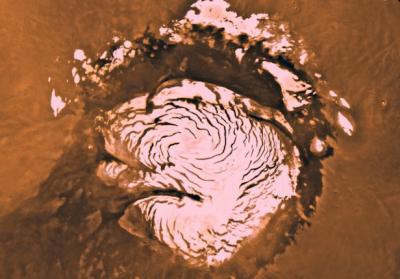
The ice caps on the Martian northern and southern Polar Regions, called Planum Boreum and Planum Australe respectively, are made up of – you guessed it – ice. But not just any ice. Only about 70 per cent of it is water in solid form. The rest is solidified carbon dioxide – called dry ice – and dust!
During the cold and dark winters on a Martian pole, nearly one-sixth of the atmosphere freezes and deposits on the permanent ice cap to form a metre-thick layer of dry ice. Months later when spring arrives bringing sunlight to the poles, the dry ice sublimes (or, directly turns from solid to gas). By summer, most of the carbon dioxide layer on the North Pole vanishes leaving behind a water-ice cap. But the South Pole has a permanent cover of dry ice and water-ice beneath this temporary layer.
Beneath the residual ice caps lies a formation called polar layered deposits, which are nothing but sheets of ice and dust stacked one on top of the other, like the pages of a book. Scientists say that since these deposits are the result of seasonal cycles and dust storms, they can give us clues about how Martian climate used to be in the past. Polar layered deposits rest on frozen ground made up of loose sand, dust and water-ice. In the north, this surface is called north polar basal unit, and in the south, Dorsa Argentea Formation.
Picture Credit : Google




